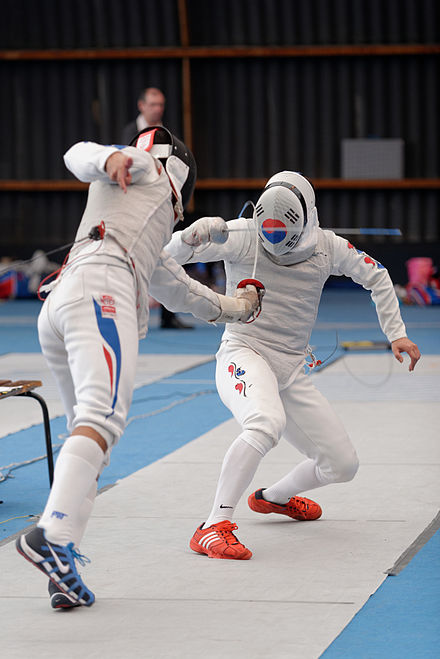
A parry is a fencing bladework maneuver intended to deflect or block an incoming attack.
The remise is a renewal of an attack in fencing. It is performed when one fencer's attack has failed, either because their opponent has parried or they missed. If the attacker immediately continues their attack in the same line, they have executed a remise. The name also is applied to repetitions of other actions which did not initially succeed. The remise is at the bottom of actions in taking priority.
Classical fencing is the style of fencing as it existed during the 19th and early 20th century. According to the 19th-century fencing master Louis Rondelle,
A classical fencer is supposed to be one who observes a fine position, whose attacks are fully developed, whose hits are marvelously accurate, his parries firm and his ripostes executed with precision. One must not forget that this regularity is not possible unless the adversary is a party to it. It is a conventional bout, which consists of parries, attacks, and returns, all rhyming together.

In fencing, a riposte is an offensive action with the intent of hitting one's opponent, made by the fencer who has just parried an attack. In military usage, a riposte is the strategic device of hitting a vulnerable point of the enemy, thereby forcing him to abandon his own attack.

The Sabre [ pronounced : ˈseɪbə ] is one of the three disciplines of modern fencing. The sabre weapon is for thrusting and cutting with both the cutting edge and the back of the blade. Unlike other modern fencing weapons, the épée and foil, where the methods of making a hit are scored using the point of the blade.

Fencing – family of combat sports using bladed weapons. Fencing is one of four sports which have been featured at every one of the modern Olympic Games. Also known as modern fencing to distinguish it from historical fencing.

In fencing, an attack is "the initial offensive action made by extending the arm and continuously threatening the opponent's target". In order for an attack to be awarded successfully, the fencer must accelerate their hand and feet towards the target. If the fencer does not accelerate the hand or foot, this is a preparation.
Rapier Combat is a style of historical fencing practiced in the Society for Creative Anachronism (SCA). The primary focus is to study, replicate and compete with styles of rapier sword-fighting found in Europe during the Renaissance period, using blunted steel swords and a variety of off-hand defensive items. Participants wear period clothing while competing, along with or incorporating protective equipment for safety. Members of the society sometimes refer to the sport as simply rapier.
In fencing, the grip is the part of the weapon which is gripped by the fencer's hand.

The flèche is an aggressive offensive fencing technique used with foil and épée.
The Amateur Fencers League of America (AFLA) was founded on April 22, 1891 in New York City by a group of fencers seeking independence from the Amateur Athletic Union. As early as 1940, the AFLA was recognized by the Fédération Internationale d'Escrime (FIE) and the United States Olympic Committee as the national governing body for fencing in the United States.
Priority or right of way is the decision criterion used in foil and sabre fencing to determine which fencer receives the touch, or point, when both fencers land a hit within the same short time-frame. After this window, if one fencer had already landed a hit, the electrical scoring apparatus would "lock-out," or fail to record, an opponent's subsequent hit, and thus the one fencer to land a hit is awarded the touch. In épée fencing, if both fencers land valid hits at the same time, they each receive a point. Because of this foil and sabre are considered conventional weapons.
Fencing practice and techniques of modern competitive fencing are governed by the Fédération Internationale d'Escrime (FIE), though they developed from conventions developed in 18th- and 19th-century Europe to govern fencing as a martial art and a gentlemanly pursuit. The modern weapons for sport fencing are the foil, épée, and sabre.

Anja Fichtel-Mauritz is a German fencer. At the 1988 Summer Olympics in Seoul, she won in the individual and team competitions, and she won the individual competition of the World Championship in 1986 and 1990. She was winner of the World Championships in 1985, 1989, 1993 as a member of the national German team and second in team competition at the 1992 Summer Olympics. From 1986 until 1996 Fichtel held the title of German champion.
The oldest surviving manual on western swordsmanship dates to around 1300, although historical references date fencing schools back to the 12th century.

Tactics are very important to playing well in modern fencing and although technique is important in the sport, using an array of tactics will help fencers make the most of that technique.
This is a glossary of terms used in fencing.














